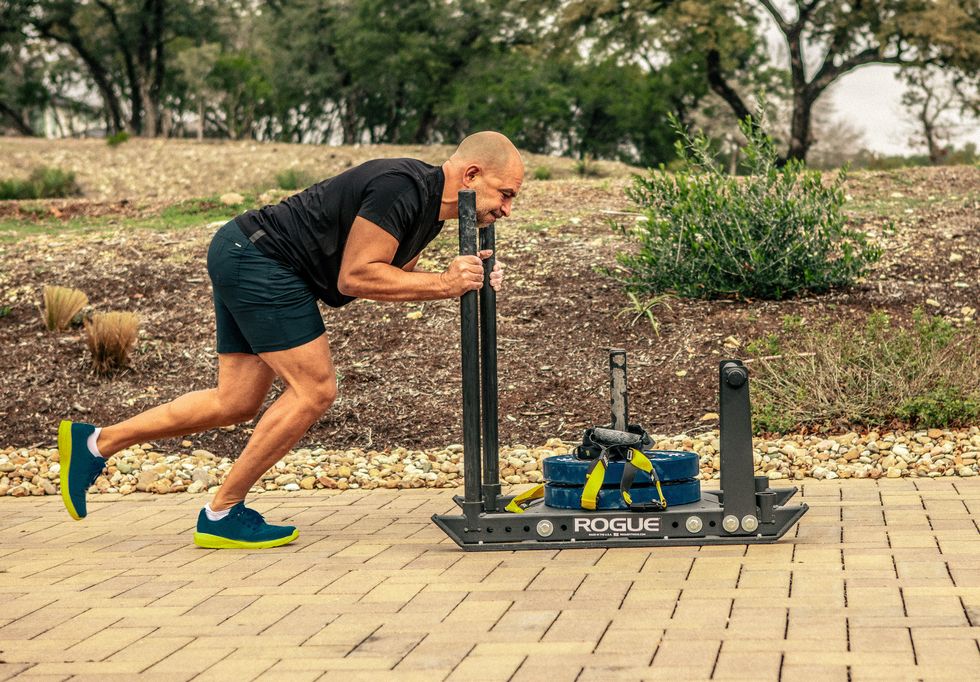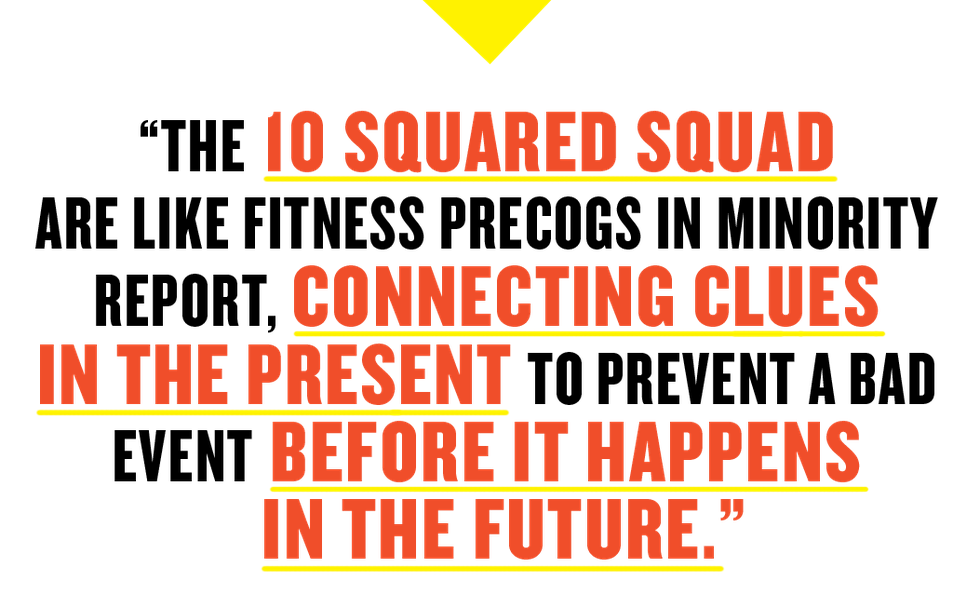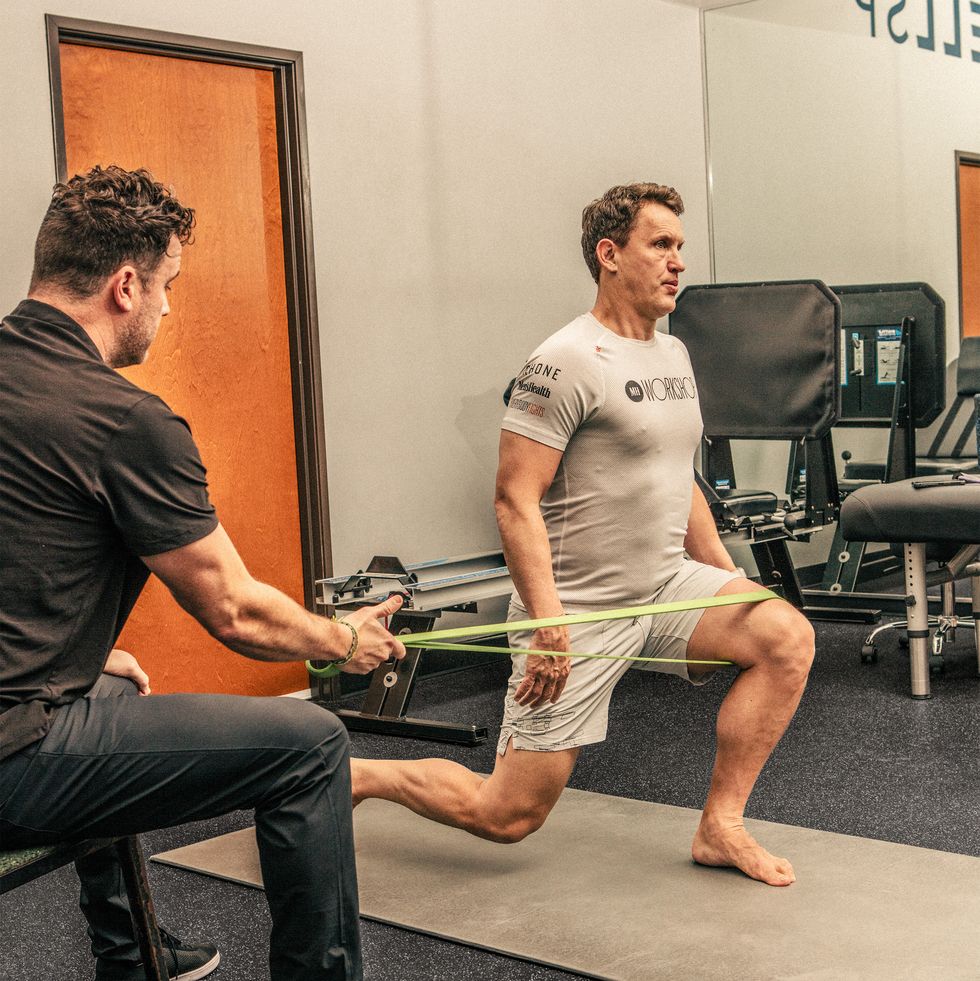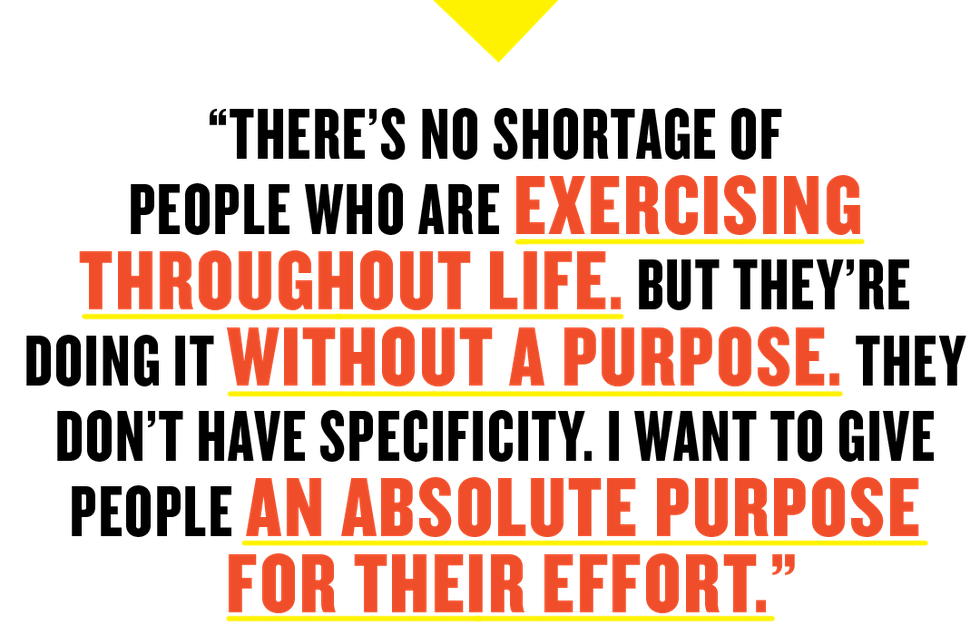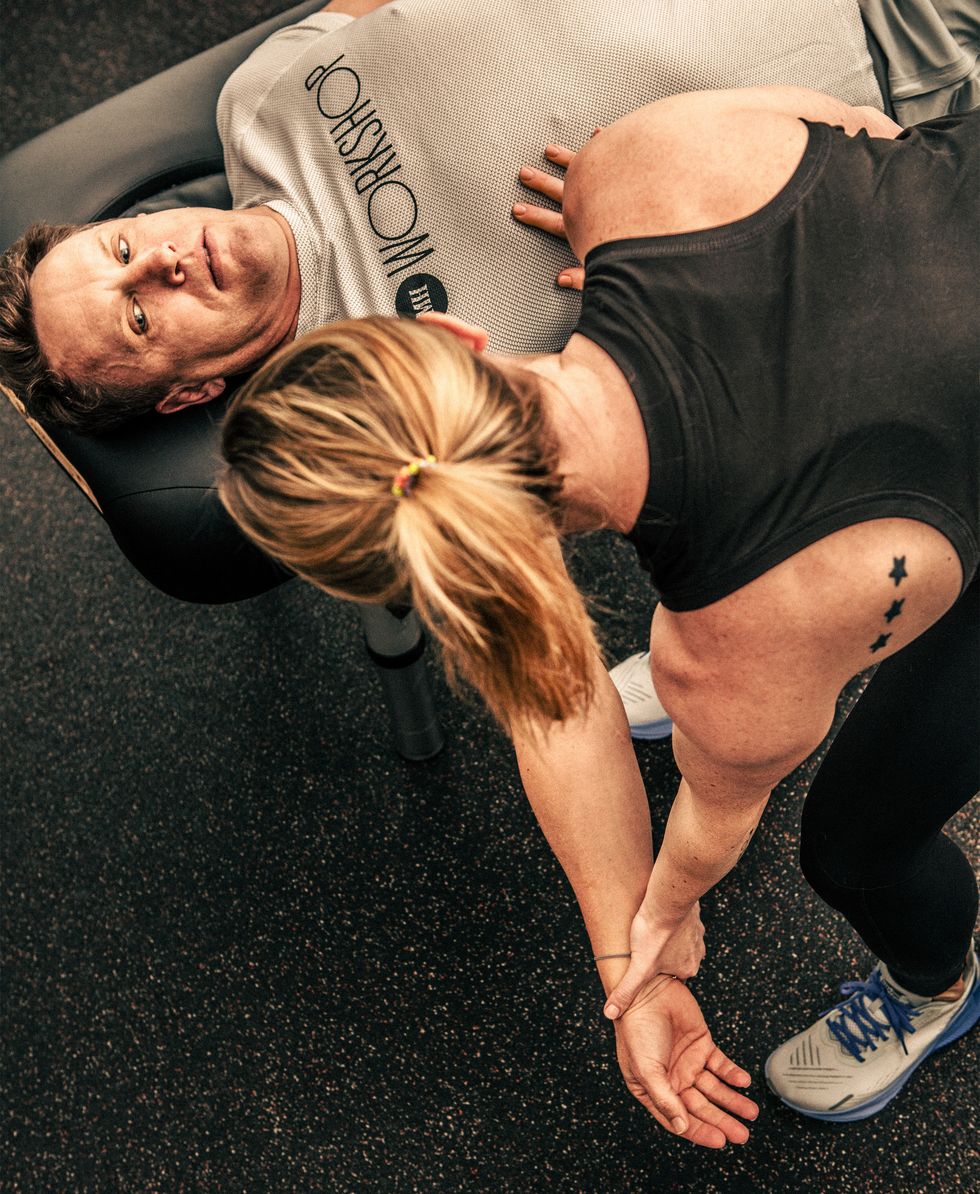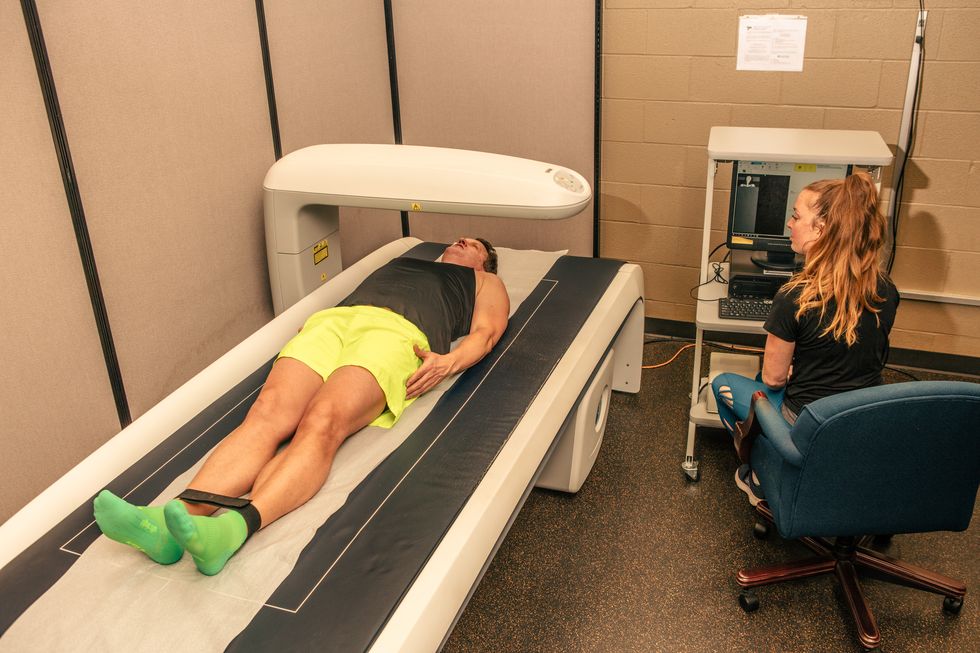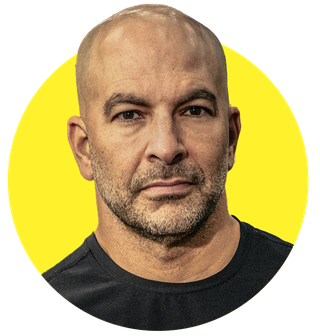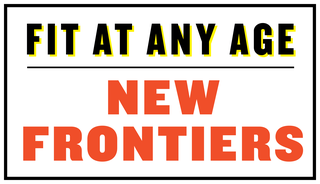
This story is part of Fit at Any Age: New Frontiers—a next-level guide to the latest science and tips for a stronger, longer life.
WHEN I SIGNED up for a movement and musculoskeletal assessment with a new performance-optimization company in Austin called 10 Squared, I was dreading the VO2 max test, when you’re strapped into headgear that measures how much oxygen you breathe in and out while you run on a treadmill and the speed is ratcheted up until you tap out. But I’m struggling already, we’re only 30 minutes in, and I’m doing . . . eye fitness drills.
Beth Lewis, a movement and exercise specialist, is holding an eight-inch vision stick with letters on it in front of me and then moving it toward my nose and from side to side and up and down. My eyes are meant to track it in and out. This drill tests visual dexterity, how quickly and accurately your eyes move across the visual field. My eyeballs strain as I focus on the letters on the stick. I push my gaze to various extremes and hold it there. It’s surprisingly hard. Lewis has big, big energy and intensely watches my progress, jotting down notes and making technical observations to Kyler Brown, D.C., a cofounder of 10 Squared and a sports chiropractor.
How your eyes move and shift drives your stability,” says Lewis. “You know your eyes are more important for stability than a six-pack? You noticing his left eye, Kyler? Might be saccadic. And that hypertonicity in his neck?” “Yes, I caught that,” says Brown. “Many people who spend all day in front of computer screens lose dexterity and peripheral vision. But don’t worry, we can work on that!”
Earlier in the session, Brown ran a series of gentle tests on my back to screen for structural or nerve-related problems. I’d told him that I had a history of lower-spine issues, and Brown put me through a sequence of exercises that stressed it in different ways. “We want to make sure your back is robust,” he says, “so you’re training without pain or fear of reinjury.” Next, it’s more stability drills, toe strength tests, and balance tests with my eyes open and closed, then a series of strength assessments. Lewis and Brown have a scary cop/friendly cop routine going as they investigate my stability, strength, and power, looking for clues that will inform my future fitness—and quality of life.
That’s the method to this muscle madness. “We’re the fall police,” Lewis says. “We’re looking for patterns of movement and areas of weaknesses that over time could compound and make you more likely to fall or get injured.” Falls are by far the leading cause of injury-related deaths in those aged 65 and older.
The 10 Squared squad are like fitness precogs in Minority Report, connecting clues in the present to prevent a bad event before it happens in the future. They will triangulate the results from the 30 drills I do for stability, strength, and cardio; factor in my body composition from a DEXA scan; then prescribe a fitness plan to power me for the next five decades. That’s not a typo; this program is not 7-Minute Abs! or Great Shape in 4 Weeks! It’s a training blueprint for your whole life.
10 SQUARED IS the cocreation of Peter Attia, M.D., 50, an Austin-based physician specializing in longevity and the author of the bestseller Outlive: The Science & Art of Longevity . It’s his attempt to scale the solution to a problem he faced first personally, then with patients in his practice. A former competitive boxer, endurance swimmer, and cyclist, Dr. Attia needed shoulder surgery in 2021. First he did prehab with Brown, then rehab with Brown and Lewis, and he believes their integration in the process (including conversations with the surgeon) helped him achieve great results.
A few years earlier, he noticed that some of the patients he could help in a clinical setting with meds struggled with the biggest longevity lever of all: exercise. “I want to fundamentally change the way people think about aging and exercise,” says Dr. Attia, who is direct and meticulous. “There’s no shortage of people who are exercising throughout life. But they’re doing it without a purpose. They don’t have specificity. I want to give people an absolute purpose for their effort.” He adds that there’s another subset of people he wants to empower, those who are too afraid to exercise because they look at fit people and think, Well, I’m not that, so I can’t do that. He sought to create a bespoke training program for every individual, centered on their goals and within a framework that forges the strength, stability, and cardio fitness proven to be essential to longevity.
The result: the Centenarian Decathlon, ten physical activities you want to do to feel happy in the last decade of your life. You work backward, he explains, reverse engineering from the physical capacity that will be necessary to do those ten activities, but with one very large caveat: The required capacity must be adjusted to account for the aging process. If an activity at 90 years old demands a given unit of strength, then you need to build something like double that amount at age 50. Dr. Attia started using the Centenarian Decathlon in 2018 to guide his own training and later unleashed it on his patients.
I’m a beta tester for 10 Squared. When I visited, the turf sections, force plates, and motion-capture stations were being installed in the 4,600-square-foot space, which is set to open later this year. Regular clients will fill out their Centenarian Decathlon questionnaire, then go to the 10 Squared facility for physiological and body-composition testing and movement and strength assessments. I did my testing at Brown’s physical-therapy center, WellSport, and the University of Texas fitness lab. Then clients will get their results as well as prescribed workouts and coaching follow-ups.
There are other longevity centers popping up, like Miora and Serotonin, that offer fitness and wellness services (think peptides, saunas, and weight-loss drugs) under one roof, but at 10 Squared the emphasis is on exercise, specifically through the motivational lens of the Centenarian Decathlon. The vibe shift that 10 Squared is leaning into is to think about exercise more in terms of quality and length of life than aesthetics or WOD times. It’s more than a glow-up for functional fitness, with its longevity-specific moves and long-term goals.
Turning 50 used to give men permission to slow down, to start thinking about retirement. But for many guys—Dr. Attia, myself—50 is more like the new 40. Or even 30. It’s a time to double down on your best practices to set yourself up for a successful second half of your life.
BEFORE FLYING TO Austin, I picked my ten activities from a list of 30 or so. It’s a sobering exercise, looking 30 to 40 years into the future, imagining yourself, your kids, your pets, and the life you want to be living. My granddad Howard was an active octogenarian who gardened, golfed, and was a sandcastle-building and steak-grilling maestro. I’m 51, I have a four-year-old and a 14-year-old, and I want to be active in their lives—and their children’s lives. I also want to still cook, travel, and maybe enter the local 5K. Certain activities (like using the bathroom unassisted and having sex without pain) I ticked implicitly, as I focused on the aspirational stuff driven by my interests (see left).
The 51-year-old author’s Centenarian Decathlon
1. Pick up a small child from the floor
2. Get out of a chair unassisted
3. Travel unassisted/ navigate a train station or airport
4. Drive alone/ get in and out of a car
5. Cook dinner for friends
6. Walk a 40-pound dog for 1 hour unassisted
7. Dance socially
8. Do 5 pushups
9. Run a 5K in 45 minutes/ 15-minute mile
10. Play golf
I go over my list with Luke Bennett, M.D., 10 Squared’s CEO. Dr. Bennett, 51, is a former emergency-medicine doctor who spent nine years as the medical director at Hintsa Performance, a coaching company that works with CEOs and sports teams to improve health and performance. He coached Formula 1 icon Lewis Hamilton for several years and met Dr. Attia at the U.S. Grand Prix in 2018, and the two became fast friends. He is calm, deliberate, and empathetic and tells me it’s normal to struggle to pick only ten activities. “That’s part of the point, drilling down to find what really motivates you,” he says. We talk about my relationship with exercise and what I like—training for and completing tough races, the bonding in team sports, and, more generally, just feeling strong (so I can pick up my 60-pound four-year-old without throwing out my back). And also what I struggle with: working out solo and combating the fat ninja that has stealthily added a couple of pounds to my body every year for the past decade.
Based on my activities, the 10 Squared team tailors my 90-minute strength and movement session. Then I get a DEXA scan for body composition and finally do the VO2 max test. The results of those two are instant—I do pretty well, scoring in a high percentile for muscle mass and VO2 max—so all told I feel fairly good after the first day.
I’M A LITTLE stiff the next morning, but my body has that sensation your mouth has after visiting the dental hygienist: My joints feel freshly flossed and my muscles primed. Lewis, Brown, Dr. Bennett, and Dr. Attia use PowerPoint to review my results. The two doctors begin by focusing on the physiological stuff, starting with VO2 max, technically the maximum amount of oxygen your body can utilize during intense exercise. It’s akin to the size of your engine, says Dr. Attia. My score of 43.8 is “pretty decent,” says Dr. Bennett, and ranks me “high” for my age group, in the 85th percentile. But Dr. Attia believes VO2 max is so important that the goal should be “elite” for two decades younger. Why? VO2 max is perhaps the most powerful marker for longevity. A higher VO2 max is associated with significantly lower mortality; someone of below-average VO2 max for their age and sex (that is, between the 25th and 50th percentiles) is at double the risk of all-cause mortality compared with someone in the top quartile.
Based on my Centenarian Decathlon goals, I will need a VO2 max of 25 in my last decade of life. VO2 max declines by roughly 10 percent per decade after your 20s and up to 15 percent per decade after age 50. With targeted training, the doctors believe I can increase my VO2 max to the desired range. But it might take eight to 16 months, and they would also like to see improvements in two other areas.
Blood pricks of my ear during the VO2 max test reveal my lactate levels and zone 2 cardio threshold, which is the second key fitness metric. If VO2 max is your engine size, zone 2 is fuel efficiency. (Yes, Detroit, you can have both!) Zone 2 is typically 60 to 70 percent of your maximum heart rate and an exercise intensity that allows you to talk, but you may need to pause your chatter occasionally to take a breath.
My data reveals my zone 2 heart rate is “very low,” 110 to 115 beats per minute, indicating that my conditioning and “overnourished” weight (23 percent body fat) are combining to make me work hard even at mellow intensity. Zone 2 training is so critical to the optimal health and efficiency of your mitochondria—the factories that burn fat and glucose to power your muscles and that decline as you age—that it makes up 80 percent of the cardio that 10 Squared recommends for me.
Lewis and Brown take over the strength analysis. Brown tells me he sees “no signs of concern for my back,” which is a huge relief. I’m psyched to find out I scored highly—in the 85th percentile—on the grip test. Dr. Bennett explains that many studies suggest that grip strength predicts how long you are likely to live. In these studies, it’s acting as a proxy for overall strength, but it’s also a broader indicator of general robustness and your ability to protect yourself if you slip.
However, I struggled on the specific upper- and lower-body strength tests and scored poorly in both the one-minute metronome pushup test and the one-minute metronome lunge test. The squad stresses that it’s good to identify weak areas now because they can be improved with training—in this case, my lack of muscle endurance, disparities in my leg strength and control, and some shoulder and breathing issues.
Stability is the fitness pillar with greatest cause for alarm. It’s a squishy thing to define, but we’re talking about more than balance and mobility. Dr. Attia defines it as the subconscious ability to harness, decelerate, or stop force. It lets you create the most force in the safest manner possible, connecting your body’s muscle groups with much less risk of injury to your joints, your soft tissue, and especially your spine. He likens stability work to a software upgrade for any movement you’re doing and says stability is the foundation for strength and cardio training.
I “underperformed” in many of the stability assessments, such as the balance screening, foot strength test, and calf raises, and the team spotted some flaws with my posture and gait. Having strong feet is important because they absorb force when you’re running or walking and have a major impact on movement efficiency. Doing foot drills is essential to improving my zone 2 and VO2 numbers.
The biggest surprise to me is eye fitness: the issues that Lewis and Brown spotted and learning how a top-down thing like vision can cause a cascade of problems. I have 20/20 vision and only recently got readers. They explain that the combination of a hypertonic (aka super-tense) neck and shoulders, decades of staring at computer screens, and the saccadic (aka tracking) issue in my left eye means that I’m tilting my head to the left. “That impacts the way you load down the chain,” says Lewis, “and may explain why you have a tilt at the shoulders and hips. With time, this kind of imbalance can significantly change dynamic stability and decrease movement variability.”
The team assesses all the results, takes a triage approach, and gives me two initial priorities: foot training and eye fitness.
The Author’s Key Results & 10 Squared’s Target Numbers
DEXA SCAN: Lean mass (aka muscle)
RESULT: 97th Percentile
GOAL: 75th percentile or above
DEXA SCAN: Body fat
RESULT: 50th percentile
GOAL: 25th percentile (for body fat, lower is better) (I need to go from 23% fat to 18% or lower.)
CARDIO: Based on VO2 max
RESULT: 43.8 High for a 50 to 59-year-old
GOAL: 53+ Elite for 30- to 39-year-olds
STRENGTH: Using a hand grip strength device
RESULT: Right: 55.1 kg, Left: 49.2 kg, 85th percentile
GOAL: 75th percentile or above (Less than 30 kg is considered frail.)
STABILITY: Single-leg Romberg test: stand on one leg eyes closed
RESULT: Right: Not stable after 5 seconds, Left: Not stable after 2 seconds
GOAL: 20 seconds without foot or lower-leg movement, swaying, or arm waving
I’M A LITTLE freaked out by the news about my weak feet and unfit eyes, but the team shares a specific ten-minute lower-leg training drill for ankle propulsion strength and gait economy and a ten-minute session to increase my eye dexterity. Both can be done at any time of day. They also give me a weekly workout plan with three zone 2 cardio sessions, two strength workouts, and daily stability drills that can be done before any movement—all with video references for form. The fitness plan dovetails with the movement and strength prerequisites for my Centenarian Decathlon and includes lots of single-leg exercises and rotational moves. Over the next four weeks, I’ll do the prescribed training and then check back in with the 10 Squared team. I’ll repeat that cycle for a year, then return to Austin and do the tests again to gauge my progress.
Already, I’ve learned three key things:
• TEACH YOUR DOGS YOGA. A tip the team gave me has really helped with all my training. When you’re standing, focus on your tripod: ground down through your big and little toe mounds and heel. This gives you a more stable setting. It’s especially helpful on any kind of single-leg work (of which there is a lot in my new regimen). I’m also feeling fast progress from doing toe yoga: spreading the toes apart and moving the big toe and other toes up and down independently of one another while keeping the rest of the foot still. And splay exercises: Find your tripod, then lift all your toes and lengthen and splay them for 5 seconds. Do 10 reps.
• SLOW DOWN TO SPEED UP. My zone 2 heart rate is really low, so to stay in that zone I have to run at a slow pace, like a 13-minute-per-mile pace, or spin gently on a bike. While that’s been a blow to my ego, it’s actually felt good in the sense that it’s not like I’m crushing my body or gutting out a brutal interval. (And you can catch up on podcasts while running, or work emails or Netflix when riding indoors.) After I build my base, the team advises adding a VO2 max–building workout, such as 5 four-minute intervals (4 minutes of recovery) at the fastest speed you can maintain for 5 rounds.
• SCHEDULE YOUR WORKOUTS. As Dr. Bennett said, all of the exercises, the protocols, the nutrition plans—it’s potentially meaningless if you can’t sustain it as a habit. Critical to that is taking the time to schedule your fitness life for four to eight weeks, he says. It reduces the friction if you know what you’re doing and when. The grail, he says, is finding modalities within the key categories—strength, stability, and cardio—that you enjoy so the activities become second nature. I’m more motivated to train than ever, but I asked Dr. Attia how he handled people who say, “I just hate cardio.” His response: “Truthfully, I don’t have a great answer: The data are the data. I show them the data about cardio fitness and longevity. The data are the data.”
Forever Fit Weekly Workout
10 Squared’s approach is bespoke, so this example targets my weak areas. (A fit person with low muscle mass would do more strength sessions.)
Monday
TRIAGE: Foot Drills Toe planks, Tripod drills, Toe Pro drills, Correct Toe yoga, Single-leg iso heel raise.
STABILITY: Crouched walk backwards, Side-lying abduction Iso, TRX hip hinge, World’s greatest stretch with hands on yoga blocks.
ZONE 2: Run for 45-60 mins.
Tuesday
TRIAGE: Eye Drills Palming, Massage, Eye stretch, Jaw iso and slide, Fast blinking, and Pencil pushups, VisionWorkout App drills.
STABILITY: See Monday.
STRENGTH: Banded pogo jumps, Landmine reverse lunge, Goblet squat to box, Standing-single-arm row, Banded pushup, Kneeling biceps curl, Feet-elevated hamstring bridge, Seated calf raise, and Down regulation banded breathing.
Wednesday
TRIAGE: Foot Drills See Monday
STABILITY: See Monday
ZONE 2: Spin or Swim for 45-60 mins
Thursday
TRIAGE: Eye Drills See Tuesday
STABILITY: See Monday
STRENGTH: See Tuesday
Friday
TRIAGE: Foot drills See Monday
STABILITY: See Monday
ZONE 2: Mellow run or uphill walk with weighted vest
Saturday
TRIAGE: Eye drills See Tuesday
STABILITY: See Monday
ZONE 5: Three to five 4-minute near max-effort run, row, or spin with 4 minutes recovery between intervals
Sunday
STABILITY: See Monday
PYO FITNESS FUN: Yoga, group fitness class, Nordic walking, rec hoops, mountain-biking
Dr. Attia’s Longevity Tips for Your 50s
BODY • As your body’s capacity to train decreases, you need to work in more time for warming up, cooling down, and recovery sessions. As important as training is, injury avoidance is equally critical. Assess your leg strength: Do a wall-sit test (back against a wall, thighs parallel to the floor). Your goal is two minutes.
MIND • This is when people start to notice a slowing of cognitive prowess. Two things stand out as ways to improve that: exercise and time in nature (without electronics). Rucking is an exceptional way to do both—work out and be outside. Also, this is probably the last time your kids will live with you. Are you making the most of that sacred time?
This article originally appears in the March/April 2024 issue of Men’s Health.
Want more longevity tips? Click the link below to read all of the stories.
 Print
Print
